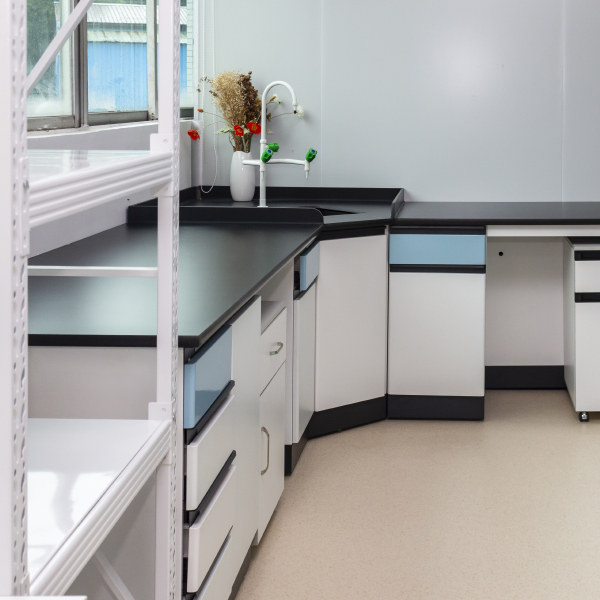Table of Contents
Working in a small laboratory can be challenging, especially when space is at a premium and your team needs room for research, equipment, and storage. Fortunately, with smart lab furniture design, you can make the most of your available space without sacrificing functionality or efficiency. In this guide, I’ll offer practical tips on how to maximize space in small labs through innovative furniture solutions, helping you create a more productive and organized environment.
Why Smart Furniture Design Matters in Small Labs
In small labs, every square foot counts. Properly designed furniture can not only provide ergonomic workspaces but also improve workflow, enhance safety, and optimize the storage of equipment and materials. By selecting the right furniture, you can ensure that your lab is both functional and efficient, even with limited space.
Here’s how you can strategically design your lab furniture setup to maximize your space:
Utilize Corner Workstations
Corners in a lab often become wasted space, but corner workstations can turn these areas into highly functional spaces. Corner workstations allow you to fit more workspaces into a small lab without disrupting foot traffic or overcrowding the room. They can be used as dedicated stations for tasks like sample prep, data entry, or equipment setup.
Key Benefits of Corner Workstations:
- Increased Workspace: Provide additional surfaces without expanding your lab footprint.
- Improved Workflow: Allow workers to stay organized in a dedicated area without interrupting others.
- Multi-Functional Use: Can be outfitted with power outlets, shelves, or small storage compartments.
Go Vertical with Storage Solutions
When floor space is tight, the best way to add storage is to go vertical. Vertical storage solutions like tall cabinets, wall-mounted shelving, and overhead storage units help free up valuable bench and floor space. These options allow you to keep equipment and materials organized without overcrowding your lab.
Practical Vertical Storage Ideas:
- Tall Storage Cabinets: Perfect for storing lab supplies, chemicals, or bulky equipment.
- Wall-Mounted Shelving: Keep regularly used items accessible but off the countertops.
- Suspended Overhead Cabinets: Ideal for storing lighter items that you need to access frequently.
Choose Compact and Mobile Workbenches
Compact workbenches are designed specifically for smaller spaces, offering all the functionality of a full-sized bench in a smaller footprint. Mobile workbenches, equipped with caster wheels, are also a great solution for small labs, allowing you to move your workstations as needed to reconfigure your space based on project requirements.
Advantages of Compact and Mobile Workbenches:
- Space Efficiency: Fit more benches into your space without overcrowding.
- Flexibility: Easily move benches to accommodate different workflows or lab setups.
- Built-In Storage: Many compact workbenches include under-counter storage to help keep tools and equipment organized.
Install Under-Counter Storage
Another smart way to optimize space is by incorporating under-counter storage in your workstations. These cabinets or drawers provide much-needed storage without taking up additional floor space. This is particularly useful for storing lab essentials like glassware, instruments, and paperwork.
Why Under-Counter Storage Works:
- Space Saving: Uses space that is otherwise wasted under workbenches or desks.
- Organized Storage: Keeps equipment easily accessible without cluttering the workspace.
- Customizable: Many lab furniture manufacturers offer customizable options to fit your specific needs.
Modular Furniture for Flexibility
Modular furniture is one of the most versatile solutions for small laboratories. These systems are designed to be reconfigurable, allowing you to adapt your space as your lab’s needs change. Whether you’re adding new equipment or reorganizing the lab, modular furniture can be rearranged, expanded, or modified to fit your evolving requirements.
Features of Modular Lab Furniture:
- Adaptability: Easy to modify or expand as your lab’s needs change.
- Space Efficiency: Designed to make the most of available space, even in tight quarters.
- Customizable Configurations: Create workstations, storage units, and benches in a way that best suits your lab.
Incorporate Foldable or Collapsible Furniture
For labs that require flexibility, foldable or collapsible furniture can be a game-changer. Foldable tables and benches can be used during peak times and then folded away when not in use, freeing up floor space. Collapsible furniture also makes it easier to adjust your workspace layout for different tasks or team sizes.
Why Foldable Furniture Is Useful:
- Space-Saving: Fold away when not in use to create more room.
- Quick Adjustments: Change the layout of your lab with minimal effort.
- Multi-Use: Can be used for a variety of tasks and easily moved around the lab.
Integrate Lab Equipment into Furniture
Integrating lab equipment directly into your furniture can free up valuable countertop space. For example, fume hoods or sinks can be built into the workstation, eliminating the need for separate equipment stations. Similarly, built-in storage for lab tools and equipment can streamline the workspace while reducing clutter.
Benefits of Integrated Lab Equipment:
- Efficiency: Combines equipment and workspace for streamlined processes.
- Space Optimization: Reduces the need for separate stations for equipment, saving space.
- Cleaner Aesthetics: Keeps the lab organized and clutter-free.
Utilize Multi-Functional Furniture
In small laboratories, multi-functional furniture is essential for maximizing space. Look for lab furniture that serves multiple purposes, such as a workbench with integrated storage or a desk that doubles as an instrument station. This type of furniture allows you to perform several tasks within the same footprint, maximizing both functionality and efficiency.
Examples of Multi-Functional Furniture:
- Workbenches with Built-In Sinks: Combine work surface and wash area into one unit.
- Storage Cabinets with Integrated Shelving: Store lab supplies and equipment in one place.
- Mobile Workstations: Serve as both a workbench and mobile storage unit for equipment.
Prioritize Customizable Storage Solutions
Off-the-shelf furniture might not always meet your small lab’s needs. Customizable storage solutions allow you to tailor cabinets, drawers, and shelving to fit your specific space and equipment. By designing storage that fits your lab’s dimensions and workflow, you can maximize every inch of available space.
Why Custom Storage Solutions Matter:
- Tailored Fit: Designed to suit your lab’s unique requirements.
- Maximizes Space: Custom dimensions ensure no wasted space.
- Organized Workflow: Helps keep tools and materials organized based on your workflow.
Conclusion: Creating a Functional, Space-Efficient Lab
Maximizing space in a small laboratory requires thoughtful planning and smart furniture choices. By incorporating corner workstations, vertical storage, compact workbenches, and modular designs, you can create a lab that’s both space-efficient and highly functional. Investing in foldable or multi-functional furniture, as well as customizing your storage solutions, will further enhance your lab’s organization and adaptability.
Whether you’re setting up a new lab or optimizing an existing one, these practical tips for lab furniture design will help you make the most of your space while maintaining an efficient, safe, and productive work environment.




